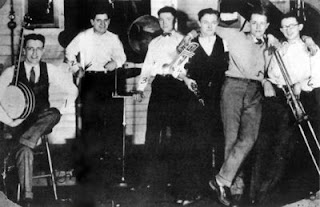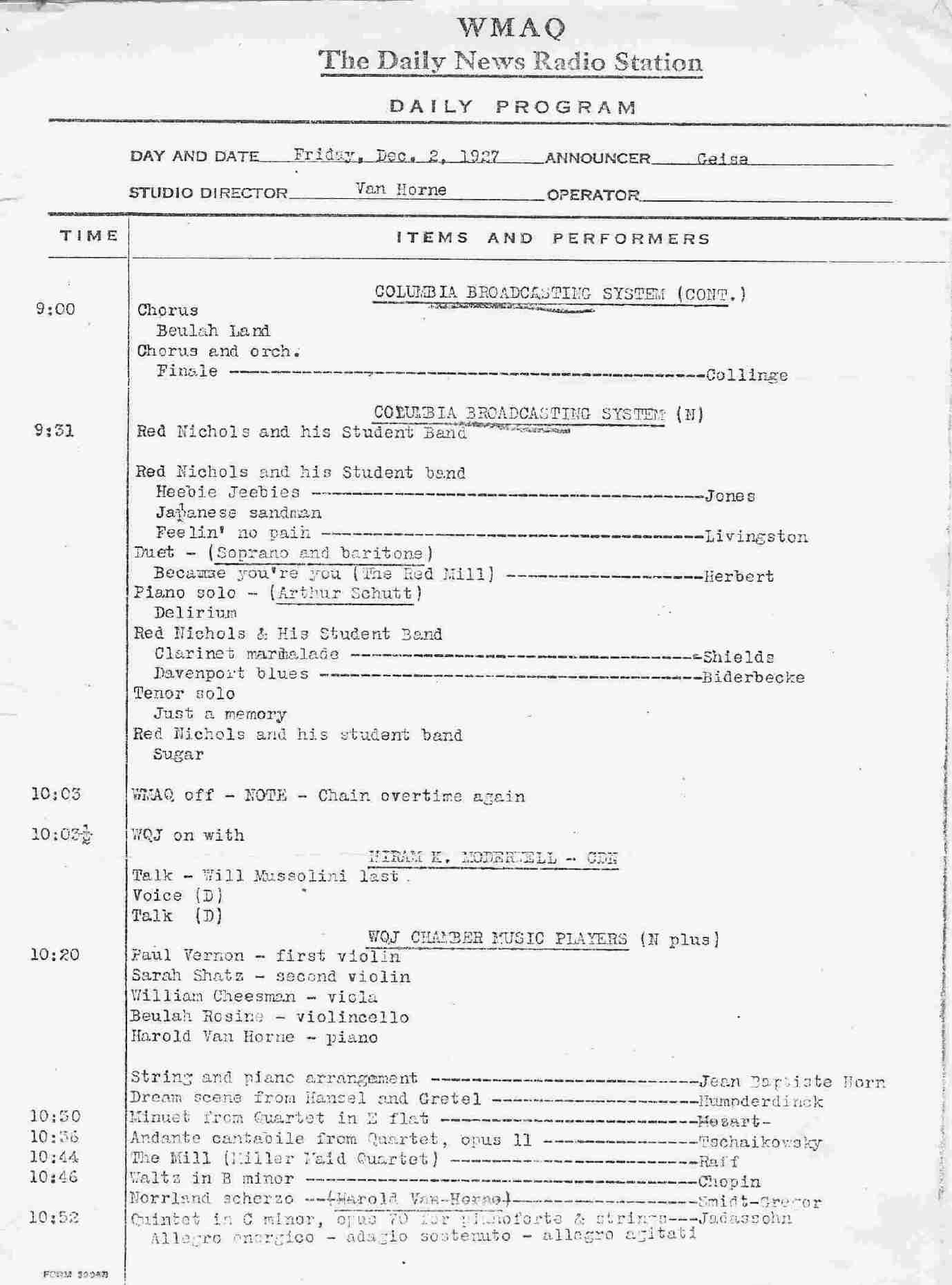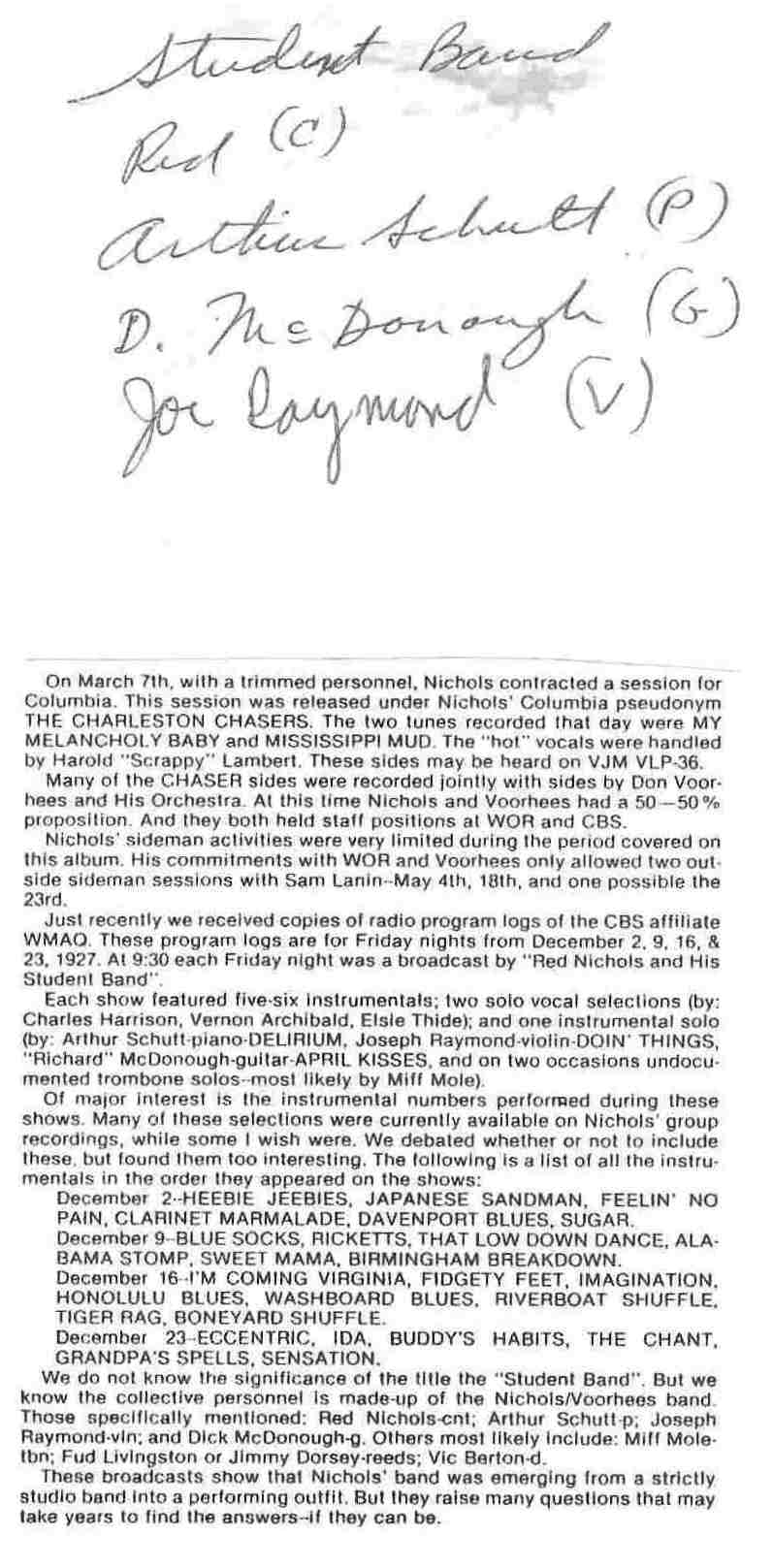 DAVENPORT
BLUES
DAVENPORT
BLUES
 DAVENPORT
BLUES
DAVENPORT
BLUES
Davenport Blues was the first
composition
by Bix Beiderbecke to have been recorded. The historic event took place
in the Gennett Recording Studios of the Starr Piano Company, in
Richmond,
Indiana, on January 26, 1925. Bix wrote, late in December 1924,
to
E. C. A. Wickmeyer of the Starr Piano Co. to arrange a recording
session.
After an exchange of letters, Bix and the contact man of the Starr
Piano
Company settled on Monday, January 26, 1925 as the date for the
recording
session.
The musicians in the group - Bix
Beiderbecke
and His Rhythm Jugglers - were: Bix (cornet), Don Murray (clarinet),
Tommy
Dorsey (trombone), Paul Mertz (piano), Tommy Gargano (drums), and Howdy
Quicksell (banjo). Bix drove with Hoagy Carmichael from Indianapolis
and
the musicians were supposed to meet Bix at the Gennett studios. Howdy
Quicksell
did not make it until the afternoon and therefore did not participate
in
the first two recordings, Toddlin' Blues and Davenport
Blues. All the musicians played in the last two recordings, Magic
Blues and No One Knows What's It All About, but
all
takes of these two songs were destroyed. Murray, Dorsey, Mertz and
Quicksell
were members of the Jean Goldkette Orchestra and we know their
whereabouts
following the Rhythm Jugglers session. Murray, Quicksell and Mertz
continued
working for the Jean Goldkette organization. Nothing is known about Tom
Gargano, a freelance drummer from Detroit. Tommy Dorsey went to New
York
and joined the California Ramblers. Apparently, Tommy Dorsey was good
friends
with Doc Ryker. Rickey Bauchelle, Doc's daughter, has letters that
Tommy
Dorsey wrote to Doc Ryker. In a letter dated February 28, 1925, Tommy
writes,
among other topics, about the Gennett-Jugglers date: "I am sure
surprised
to hear that Bix is going with Charley Straight. I thought he was going
back to school. I hope he dont forget I am living if he gets any
royalty
at all because that trip cost me sixty bucks, they told us in the
Gennett
place that the records would not be out for about two weeks yet."
Excerpt from Randy Sandke's "Bix Beiderbecke:
Watching
a Genius at Work", p. 10-12. To
read about this booklet, click here.
On January 26, 1925 Bix made his
recording debut as a leader. This record would be issued under the name
of Bix Beiderbecke and his Rhythm Jugglers. Bix's nonchalant attitude
towards
this date (and perhaps his career in general) is described by Hoagy
Carmichael
who was present at the session. According to him, the musicians
proceeded
to get drunk to the point that the last two tunes they recorded were
deemed
unacceptable for release. (To be fair, however, the Gennett file card
mentions
technical problems as well.)
Hoagy took photos of the session.
These and a handful of others that show Bix in action (including the
quick
glimpse we get of him in Paul Mertz's home movies of the Goldkette
band,
and the recently discovered newsreel of Bix with Whiteman) all
demonstrate
an attitude towards playing that seems casual in the extreme. Most
trumpet
teachers advocate good posture to facilitate breath control, but Bix is
always seen slouching, or sitting with legs crossed. The recommended
way
to finger a trumpet is with the fingertips straight over the valves,
but
Bix's are bent over in a lazy fashion. Dic Turner, a friend and admirer
of Bix as well as an amateur trumpeter, said Bix played leaning over at
the floor at about a 45 degree angle, and the photos bear this out.
This session will provide much
evidence of Bix's divided attitude towards himself and his music. He is
at the same time dead serious and insouciant to the point of
negligence.
Any good jazz player must find a balance between being focused and
loose,
but with Bix this conflict, combined with his drinking, would later
develop
into a insurmountable problem.
Nevertheless the session did
provide
us with the only example of a jazz tune of Bix's composition:
"Davenport
Blues". Although this tune has at times a "bluesy" feeling, it is again
not a 12-bar blues.
The tune consists of a four bar
introduction, a 16 bar verse followed by a 32 bar chorus, after which
the
the verse and chorus are repeated with a 2 bar extended ending. Two
things
are unusual about this piece. First of all, Bix uses the same melody
for
the verses, but both choruses have have different melodies (though
nearly
identical chords.) Only on the last refrain of the chorus do we hear
the
familiar melody which we identified as "Davenport Blues."
The second unusual feature of
"Davenport
Blues" is the way both choruses end in different chord progressions. In
the first chorus Bix plays breaks over chords reminiscent of a similar
spot in "Jazz Me Blues".
On the second chorus Don Murray
plays the breaks on clarinet over a chord progression more like
"Ostrich
Walk." It is as if Bix couldn't decide which one he liked best. This
indecision
is mentioned by both Bill Challis and Esten Spurrier in regard to Bix's
later piano pieces; Challis: "Each time he'd play a passage he'd think
of some way to improve it," and Spurrier, "He said he'd compose three
bridge
passages but couldn't decide which one to use, and that I had to select
the best."
Carmichael says that "Davenport
Blues" was created on the spot. "Bix stated doodling on his horn.
Finally
he seemed to find a strain that suited him but by that time everybody
had
taken a hand in composing the melody... As far as I could see, they
didn't
have any worked out, or tune for that matter, but when the technician
came
in and gave the high sign, they took off." On the other hand, Paul
Mertz,
the pianist on the date, remembered Bix bringing a lead sheet. The
arrangement
does seem to be too involved for a pick up band to play from memory
with
little rehearsal, especially given their intoxicated state.
Although Bix is often identified
with a penchant for the whole-tone scale, his break in the opening
chorus
is the only recorded example of him actually playing one (tough it's
still
one note shy of a full six-note whole tone scale.) Later on, though,
his
piano pieces would abound in progressions of augmented 9th and 11th
chords
which are derived from whole tone scales.
Since this is Bix's first date
as a leader, it is interesting to consider his choice of sidemen and
tunes.
All the musicians in the band were drawn from Goldkette's working band
(with the exception of Tom Gargano, a freelance drummer from Detroit,
where
the others were based). Bix's had a tendency to contract musicians he
was
currently working with for recording dates. Bix has been criticized for
not going beyond his narrow circle to recruit musicians who were more
on
his level. Yet he undoubtedly felt comfortable in the presence of these
comrades, and in Tommy Dorsey and Don Murray he found very able
support.
He developed a particularly close relationship[ to Don Murray, and Bix
seems to be happiest and most relaxed in the photos of them together.
Don
Murray's premature death in 1929 would be a big personal blow for Bix.
Of the material that Bix chose
to record in addition to "Davenport Blues," there was another tune
written
by La Rocca and Shields of the ODJB, called "Toddlin' Blues." The
Gennett
file card lists two additional tunes that were recorded but unreleased.
The first was "Magic Blues." No composer is credited so it may have
been
another Beiderbecke original (or maybe the on-the-spot composition
Hoagy
Carmichael recalled) which perhaps could provided us with another rare
glimpse of Bix playing a 12-bar blues. The other was a pop tune
entitled
"No One Knows What's It All About" written by Harry Woods. It had been
recorded by the Memphis Five and the Varsity Eight in a version that
features
Adrian Rollini. Paul Mertz said that Bix's arrangement included "a
tricky
tempo change in the middle, and by now we were all pretty well
lubricated
and kept muffing the tempo change. We never really got it right."
What is interesting to me is that
this session represents the only time Bix attempted to record a jazz
tune
of his own composition. There would be many opportunities to record
more
with Trumbauer or under his own name but he declined. This is
especially
puzzling given the many accounts of Bix sitting at the piano working on
his own music. Laziness or lack of discipline don't explain Bix's
disinterest
in this area. I think it had more to do with Bix's ambivalent feelings
toward jazz.

Davenport Blues is a number composed by Bix Beiderbecke
and recorded by him, with his Rhythm Jugglers, in 1926 (top photo).
With him were Don Murray on clarinet and Tommy Dorsey
on trombone. It is very badly recorded, pre-electric, muddy and
muffled. Only Bix’s cornet emerges with any clarity. Davenport Blues is
not a real blues. It is a jaunty, medium tempo number which in Bix’s
recording consist of 3 sections, each of 32 bars. The first section is
the verse; the melody here has a preliminary unfinished quality about
it as if leading to another more striking one. The second section
consists of a 16 bar variation on the verse theme, followed by a
reprise of the theme itself. The third section is the chorus, the most
distinctive, bitter sweet melody starting with two four note rising
arpeggios, then descending to “blue” Aflat and a trill, followed by a
repeat, a variation and a reprise. Bix’s cornet is tender and relaxed;
he plays very much “on the beat” giving it, to our ears, a rather
archaic quality.
This archaic quality is even more apparent in the version recorded a
year later by Red Nicholls.
If Bix plays on the beat, Nicholls is nailed to it. It is however a
much clearer electric recording and we get a true idea of Nicholls’s
clipped cornet and Miff Mole’s effortful trombone. The tempo
is similar to Bix’s recording. The order is reversed. The chorus is
played first on cornet. The verse comes in with Mole’s trombone before
reprise of the chorus on alto sax, piano and cornet in that order. It
is well drilled and clean but to our ears, even more so than Bix’s, it
is corny – on the beat, jerky and ragged.
Bunny Berigan,
dubbed Bix’s successor in the 1930s by virtue of the lyrical quality of
his playing, also recorded Davenport Blues with his own band in 1938.
Rhythmically and musically this is more sophisticated. Sixteen bars of
the verse from the band are followed by the chorus melody on Berigan’s
trumpet, much better played and with more subtlety than either Bix or
Nicholls. Berigan’s rather more Louis Armstrong like tone gives it more
drama and depth.
Louis Armstrong, recently deceased, was the
subject of a memorial concert at the Queen Elizabeth Hall, London, in
November 1971. On that night Davenport Blues was played as a duet by Alex
Welsh (lower photo above) on cornet and Fred Hunt on
piano. A CD
of
Alex Welsh’s contribution to the concert has been issued (but it is
hard to get). This time it is slowed right down, concentrating solely
on the chorus. Welsh’s entry after an opening piano flourish from Hunt
is stately. The theme is played simply with some flourishes but never
straying far from the melody. At this tempo the melody opens out, and
seems more like a real blues than it is. Welsh’s cornet is clean; it
has something of Bix’s bell like tone but with a burnished quality that
gives it more warmth. Welsh plays the “blue” Csharps and Aflats with
relish, leaning on and roughening them. He gives the melody weight,
drama and pathos.
Hunt’s solo starts with broad sweeping
arpeggios interrupted by a brief boogie passage. The florid right hand
gives way to single note flurries, a section in double time with stride
like piano towards the end. Then Welsh returns. He plays an inversion
of the melody, with interpolations of real blues inflections before
coming back to the melody and some double time interplay with Hunt’s
piano. In the second sixteen bars he stays close to the melody, with
grace notes over double time, then to the last four bars played simply
and straight to a gentle close in slower time. At the end is Hunt's
poignant reprise of the opening notes of the melody high up over
Welsh’s long held final low note on cornet.
There are other
versions of Davenport Blues. But there is no doubt that the version
played by Alex Welsh and Fred Hunt at the Queen Elizabeth Hall on 28
November 1971 in honour of Louis Armstrong is the finest ever recorded.
I am indebted to Hans Eekhoff
for generously sending me the images
of the record labels, of the Gennett file card and of the photograph of
the Rhythm Jugglers, to Randy Sandke for kindly giving me permission to
transcribe the discussion of Davenport Blues from
his booklet "Bix Beiderbecke:
Observing a Genius at Work", and to Rickey Bauchelle for the gift of a
copy of the letter from Tommy Dorsey and for her friendly help.
From
http://www.scottchilders.com/timecapsule/TCWMAQ.htm
WMAQ Radio. 1922-2000.
"In 1922,
The Chicago Daily News kicked around the idea of adding a section to
the
newspaper devoted to the new medium - radio. After the new section ran
for
awhile, newspaper execs realized that instead of promoting other
stations, they’d
be better off with their own facility. This was no doubt due to the
fact that
their rival, the Chicago Tribune had been experimenting with radio by
airing an
hour of news on Westinghouse’s KYW. (By 1924, the Tribune purchased
WDAP
and WJAZ, which were merged to become WGN “World’s Greatest Newspaper.”)
A joint venture was formed between the Daily News and the Fair
Department Store.
The Daily News appointed William Hedges station manager. Then, Walter
Strong,
the paper’s managing editor hired Judith Waller away from the
advertising
agency J. Walter Thompson. Waller was appointed the new stations
program
director, announcer and talent scout. She had absolutely no radio
experience!
Despite this, WGU Radio signed on the air on April 13, 1922. After only
a few
days of broadcasting with some clunky old leftover transmitting
equipment, the
station was taken off the air and retrofitted with a new 500 watt
transmitter
and antenna system, located atop the Fair Store. The station finally
signed back
on in October. Upon the inauguration of the new transmitter, Secretary
of
Commerce Herbert Hoover changed the station’s call letters to WMAQ. The
calls
originally had no meaning, but went on to form the motto: We
Must
Ask Questions. By 1923, the Daily News
purchased the
Fair Store’s interest in the station and moved WMAQ to the LaSalle
Hotel. WMAQ
originally shared their broadcast frequency with another radio station
- WQJ.
This was common practice in the early days of radio. In 1927, the
newspaper purchased WQJ and WMAQ assumed the entire broadcast day on
670 kHz. The
station later moved in with the newspaper at the Daily News Building on
Madison
and Clinton in the West Loop in 1929. In
addition to providing musical selections, WMAQ also aired educational
lectures,
household features from the Daily News, children’s programming and was
a
pioneer in radio sports."
Beginning Sunday afternoon September 18, the competitive element in nation-wide broadcasting enters by way of the 16 carefully selected high powered radio stations included in the Columbia Broadcasting System's network, which covers the United States east of the Rocky Mountains.
In spite of the fact that this is still a day of pioneering in
Radio,
the new Columbia chain enters as a lusty full strided youth, and a well
manned organization, and a wealth of musical and entertainment
experience
as a background.
Don Voorhees, who has the record for the longest unbroken orchestra run on Broadway, and who has been musical director for Earl Carroll since the second edition of the Earl Carroll Vanities, has been put in charge of a dance and specialty orchestra.
Red Nichols, popular for his phonograph record and Radio work, heads a specialty musical group.
Chamber music groups, a string quartet, and several dance orchestra units are included in a list that already totals 80 musicians and groups under exclusive contract.
The signing of these artists and organizations represents an innovation in the field of nationwide radio broadcasting as a result of the Columbia chain's policy, which sells not only the chain over which the program is broadcast but also the program itself, together with an adequate staff of Radio showmen, continuity writers, directors and technical experts, to insure that the programs will justify the slogan which the Columbia chain has set for itself. The slogan is: "Always entertainment on every Columbia hour.
Major J. Andrew White, dean of broadcasters and builder of the first
Radio station designed to furnish free entertainment to Radio set
owners,
as Vice-President of the Columbia chain brings to the Columbia network
an
experience dating back into Radio's very earliest days, and brings also
his pioneering spirit which has in the past been responsible for so
many
of the forms of Radio entertainment so popular today.
Work has progressed to the finishing stages in the three new indoor and two outdoor studios for WOR, which is the key station to be used by the new Columbia chain. [Note -- these studios were still uncompleted at the time of the initial CBS broadcast, and in fact network master control ran from a makeshift control facility set up in the WOR men's room.]
No announcement as to the sponsors of the programs have yet been
made,
except in the case of the Columbia Phonograph company, which will have
the hour between 9 and 10 o'clock each Wednesday evening.

